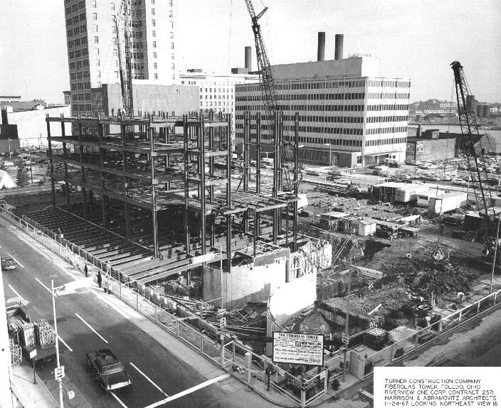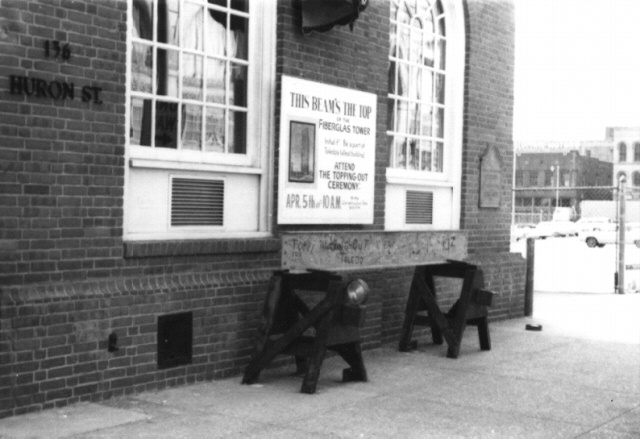So, the future is finally looking up for the Fiberglas Tower! That’s a good thing, since, as this Blade story from 2016 notes, the tower, now known as Tower on the Maumee, has been empty for a third of its existence. That’s a bad thing.
Many a hope was pinned on the building of the tower when plans started taking shape in the 1960s. It was only Toledo’s tallest building for 11 years after its opening in 1971 (until One Seagate opened in 1982), but its simple elegance will always grace Toledo’s skyline – more than that green monstrosity on Summit.
When the groundbreaking was held on May 1, 1967, the Fiberglas Tower was proclaimed as a significant step towards Toledo’s future, marked Toledo’s entry into a new era, that it would accelerate downtown development momentum and reawaken the entire central business district.
So, no pressure there.
The groundbreaking was four years in the making. It had its genesis in the Riverview concept, introduced in October, 1963 by Columbus developer John W. Galbreath, who proposed a six square block, $25 million development bounded by Monroe, St. Clair, Madison and the Maumee river.
Not everything in the plan came to pass (pedestrian overpasses, a heliport), but the centerpiece – “a 30-story office building, along St. Clair approximately where the Fort Meigs Hotel now stands, which would be the tallest building in Toledo” – certainly stayed.
The $15 million building was leased almost entirely by Owens Corning and featured an open-office design, apparently the first building in corporate America to do so. It was part of a larger urban renewal project, Riverview I, which tore down a number of buildings around the Summit-St. Clair-Madison blocks to accommodate both the Fiberglas Tower, the Federal Building on Summit Street (a truly unremarkable building which is now gone) and the new headquarters of Toledo Edison.
In 1993, Owens Corning announced plans to vacate the Fiberglas Tower by 1996. At the time the only question was where (Downtown? Monclova Township?) but the company eventually settled on the Middlegrounds. The building was added to the National Register of Historic Places in 2012 but has sat forlorn until recently when it got a new life.
Here’s what it looked like in its infancy:





But who were Mark and Dawn? During construction, the names Mark and Dawn could be seen on one of the highest beams of the Fiberglas Tower’s steel skeleton. We will probably never know. Zip Line, The Blade’s problem-solving column, couldn’t say.

I did want to dwell for a moment on the Top of the Tower restaurant, because I remember going there and being dazzled by the view (and that’s it).
The Gladieux Corp., a high-profile Toledo food service and catering business (the company’s namesake, Virgil Gladieux, built the Sports Arena in 1947), was optimistic about the Top of the Tower, but by the early 1970s there wasn’t much to do downtown anymore at night as downtown was “limited to two theaters and a burlesque hall, the Sports Arena, and a handful of restaurants,” business writer Homer Brickey wrote on March 31, 1970.
But one remembers how great the Colony Restaurant was forty years later. The Top of the Tower? Not so much. It never made much of a mark. It churned along on its view for a decade and closed on Dec. 31, 1982. The contents were sold off almost immediately.
I looked high and low for a Mary Alice Powell review of the Top of the Tower but I couldn’t find one…at first. Then I stumbled across one in the Peach Section from July 27, 1979 (that link will get you close, anyway). “Dinner at the Top of the Tower was a so-so experience, one of those meals that can be chalked up as not so good that you want to rush back, or not so inferior that you will never return,” she wrote. The liver was overdone and the duck was dry. The salad bar was pretty good however.
Side note: In the same column, Powell confessed she had six hot dogs at Joe’s International Hot Dog on Alexis Road. That’s admirable.
The Blade, in an editorial entitled “Flop at the Top,” laid the failure of the restaurant at the feet of the Gladieux Corp. They could do banquets, institutional food settings and turnpike plaza food like nobody else, but “when the task is to run an outstanding, quality restaurant with excellent food, fine service and inviting settings in the public marketplace, the track record of the Gladieux Corp. in this city leaves much to be desired,” citing its failure of Kin Wa Low, Grace Smith’s and Arne’s – three restaurants I do not even remember.
Here’s a link from WTOL detailing the renovation of the Fiberglas Tower into living space.

I may be incorrect. But I thought the top of the tower restaurant revolved. Am I wrong did it not turn as you sat there and ate your dinner?
Never revolved.
Yes, I remember it revolving too.
Yes, it did revolve. I remember having taken my aunt there for her birthday dinner.
YES, IT DID….AND WAS DURING THE MID TO LATE 1970’S….MY HUSBAND AND I ENJOYED MANY FINE MEALS THERE…AT NITE IT ROTATED..NOT SURE IT DID DURING THE DAY…THE WINDOW SEATING WAS ON A VERY SLOW SLOW REVOLVING PLATFORM THAT MOVED EVER SO SO SLOWLY. AND IT WAS INCREDIBLE… AND A HIGHLIGHT…
It was square and did not revolve. I worked there in the late 70’s.
I’m doing some family history, and I believe my grandmother, Faye Powell Johnson was a cook there for a time.
I can confirm, I am the Facility Maintenance manager or this building and can positively say that restaurant DID NOT rotate. No way, no how could that ever been possible. There is one in Cincinnati that does.
You may be remembering the restaurant in Detroit that revolved.
Yes. That was The Summit, on top of the Renaissance Center .
No revolving there i worked a few years there and the food was excellent hands down and if anyone wants questions answered i would do my best to do so.
I was a waitress at Top of the Tower. The restaurant couldn’t revolve, but we served a lot of cocktails on weekends….so some of the patrons heads might have been spinning
Jackie…this is Trudy…I worked in the cocktail lounge! You were so adorable! I enjoyed working with you!
I was Trudy Baker at the time !
Wasnt there a fire in that building at some point?